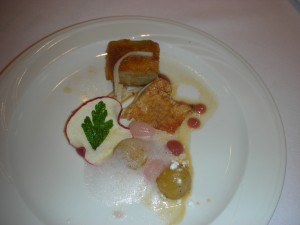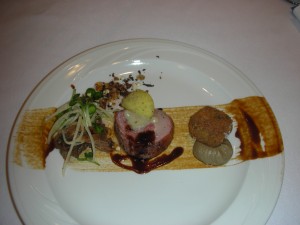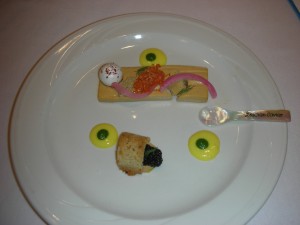It is one of the happiest of all life’s coincidences that Gold Medal Plates St. John’s almost always takes place on my birthday. It’s a very good place to celebrate an anniversary, and a splendid group of friends to share it with, especially when the occasion is something of a milestone. One highlight was being called on stage so that the band could sing Happy Birthday to me – thank you, Jim Cuddy, Sam Roberts, Anne Lindsay, Colin Cripps and Devin Cuddy! They were all in very fine voice, thrilling the sold-out crowd at the Delta with the rest of their performances and helping to sell a ton of trips. The incomparable Tessa Virtue was the evening’s MC, to the delight of all, and Scott Moir conducted the interview of the athletes with great charm and energy.
Gastronomically, standards were as high as I can remember in this city that has become famous across Canada as a culinary destination. Our team of judges performed impeccably, led by our St. John’s Senior Judge, author, journalist and broadcaster Karl Wells with chef and educator Bob Arniel of Chef to Go; food writer and blogger for the Independent, Nicholas Gardner; chef, caterer and restaurant critic, Peter Gard; and last year’s gold-medal-winning chef, Mark McCrowe of Evoo.

Taking the bronze medal, Adam Grevatt of Blue on Water worked his chosen wine, the lightweight, frizzante, off-dry Selkie from Jost Winery in Nova Scotia, into his dish in a number of ways. His principal protein was a square of soft, unctuously fatty pork jowl sandwiched between slim layers of toasted citrus brioche – the most decadent sandwich you ever saw. Almost everything else on the plate was designed to cut such richness – and made excellent use of locl rhubarb and Nova Scotian honeycrisp apples. There was the apple balled and poached in a Selkie-infused caramel and there again as a Selkie and apple foam. Apple slaw was delightfully refreshing while an apple and parsley chip provided textural contrast. Chef had mixed the Selkie with rhubarb and formed wobbly little orbs of tangy flavour and used the rhubarb again in a ginger reduction to form a different, equally brisk purée. A final sprinkle of coriander and cardamom powder added an interesting floral note to the dish.

We awarded the silver medal to a veteran of our competition, Roary MacPherson of Oppidan. He chose local Newfoundland lamb (a hardy, exceptionally flavourful breed) as his main event, offering three different cuts. In the centre of the plate was a thick slice of the rolled, poached breast, the meat wonderfully tender and succulent. It was topped with a dab of sunchoke purée and a dense little dumpling to help mop up the juicuiness. Beside it was a mound of pulled shank meat that had been braised with a little pork and a vegetable mirepoix and now wore a crown of pickled and julienned rutabaga with pea shoots and microgreens. On the other side was a crisply coated croquette of moist lamb neck paired with a hummock of eggplant purée. The plate was painted with a broad stripe of haskap berry jus simultaneously tangy and sweetly fruity, and finished with a texturally fascinating granola of puffed rice, quinoa, oats, garam masala spices and a jaunty jalapeño jelly. It was a beautifully composed and presented dish, well matched to one of the evening’s big red wines, the Kraze Legs Merlot from Kraze Legs Vineyard and Winery in British Columbia.

And our gold medallist? As has been the case across the country this year, experience has been a factor in the creation of superior competition plates. Taking gold for the second time was Roger Andrews of Relish Gourmet Burgers with a dish that was elegant to look at and heaven to eat. Its main event was a rectangular slice of a trembling, moussy, honey-coloured sea urchin bavarian, its uni flavour perfectly judged. Chef had removed a round piece of the slice and set it on the other side of the plate then topped it with a teaspoonful of the splendid Acadian sturgeon caviar, topped with a curl of crisp shallot toast. The hole in the slice of bavarian was now filled with a morsel of chewy buckwheat crisp. Several elements were set out on top as a garnish, a clever play on the usual egg-and-onion accompaniments of a traditional caviar service. A tiny dome of pure white meringue represented the egg white; it was subtly flavoured with pink peppercorn and finished with three or four specks of cayenne. Playing the role of yolk were very fine shavings of a bottarga made by pressing and drying the vivid orange-coloured roes of scallops. It tasted like an amplification of the uni bavarian – such a flavour of the sea! Two curls of lightly pickled shallot stood in for the onion. The final components of the dish were three dots of rich lemon curd spaced far apart and topped with a green chive oil – optional condiments should anthing be required. Chef’s chosen wine was the best match of the evening – a lovely dry, sparkling white from Nova Scotia – Benjamin Bridge Tidal Bay.
So we now have three Nova Scotian wines coming to Kelowna in February. I suspect tey will open some eyes in the rest of Canada! And chef Roger Andrews joins the increasingly impressive roster of champions who will do battle for the ultimate title. Three cities to go! Next Monday, Montreal!
